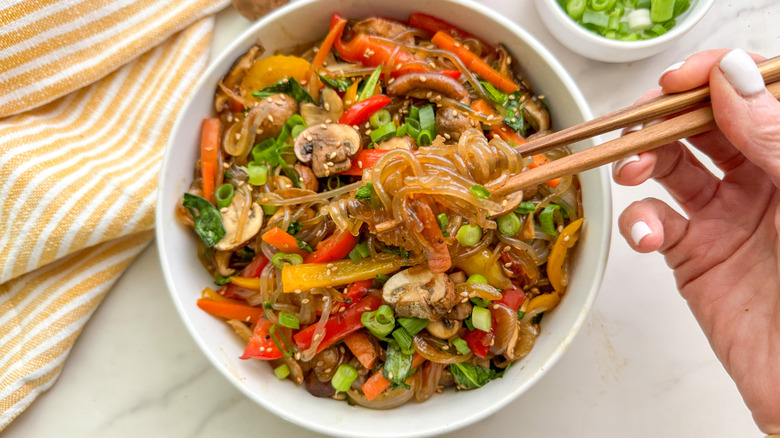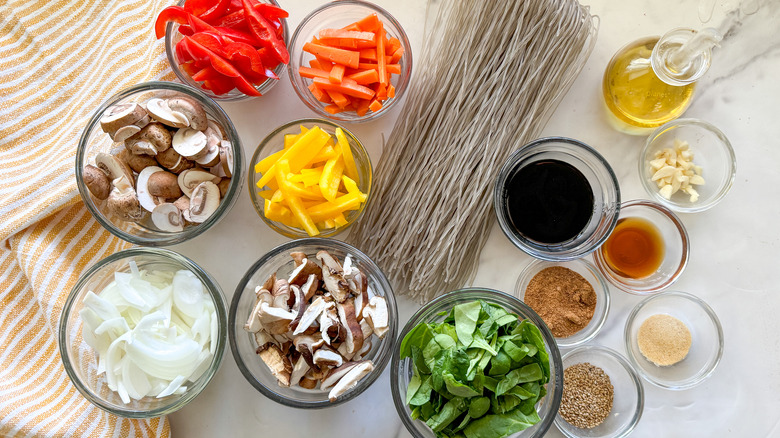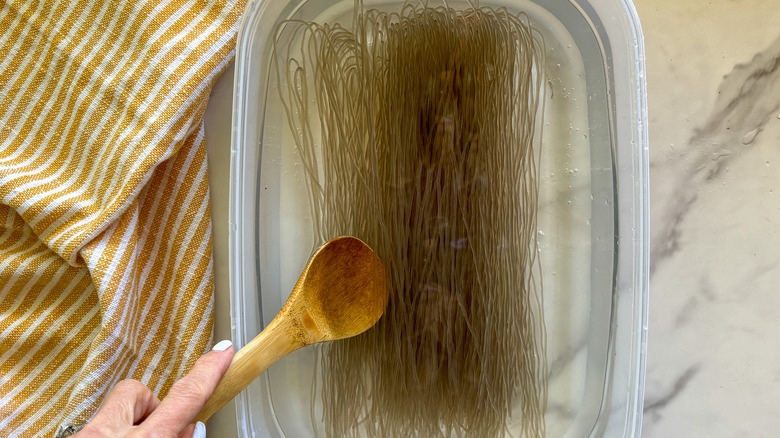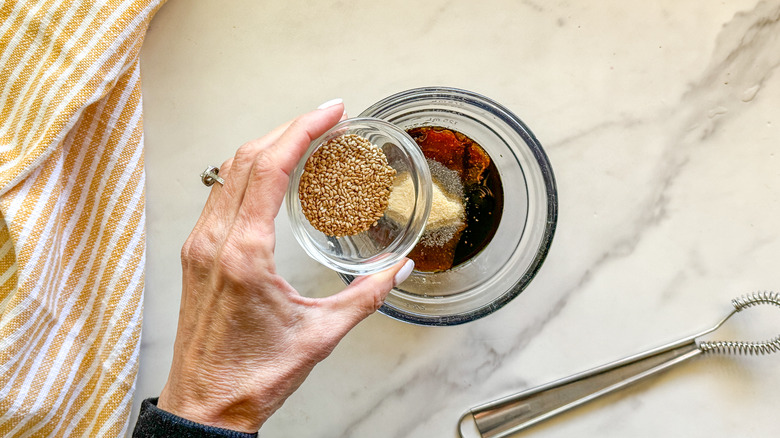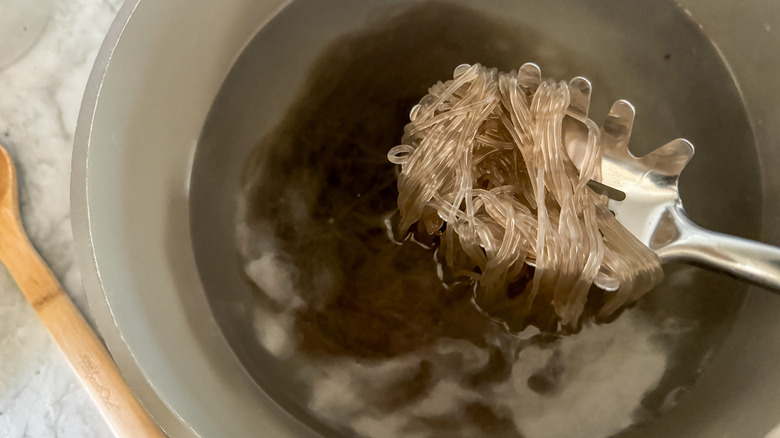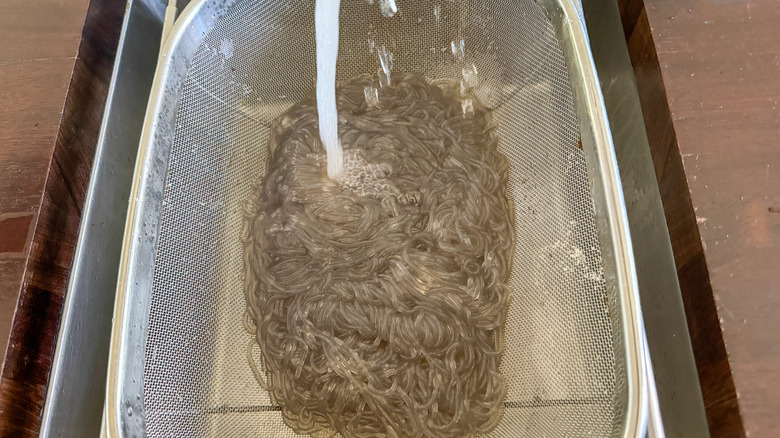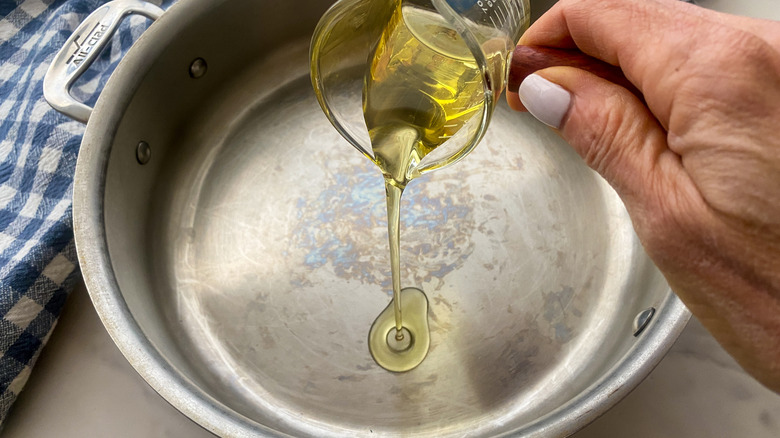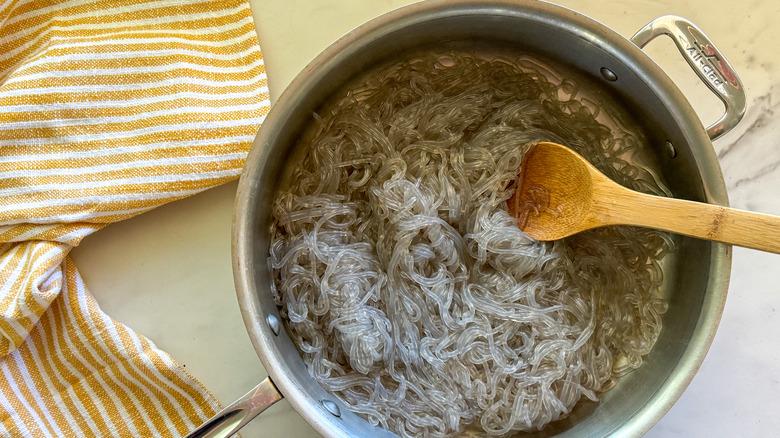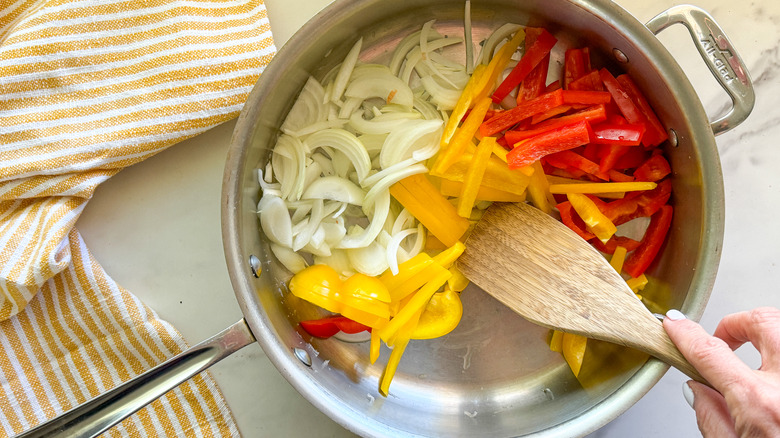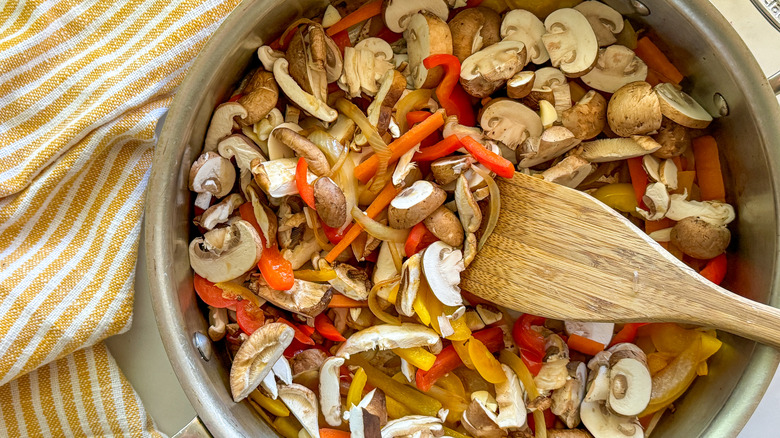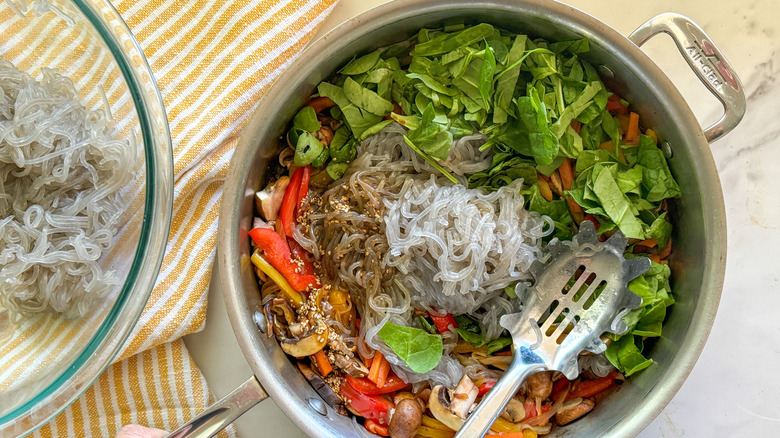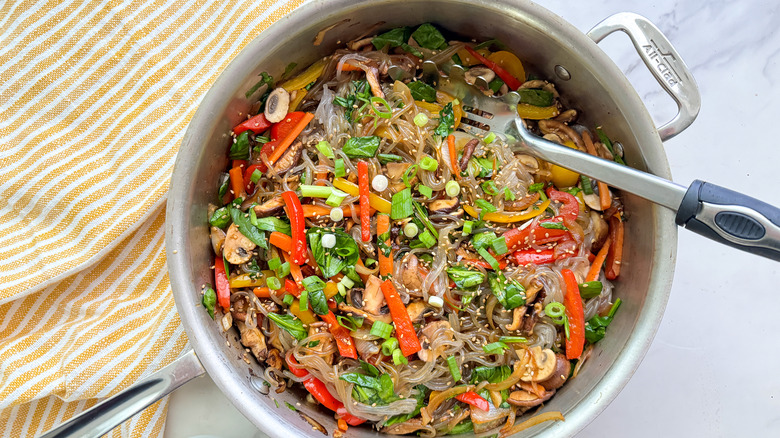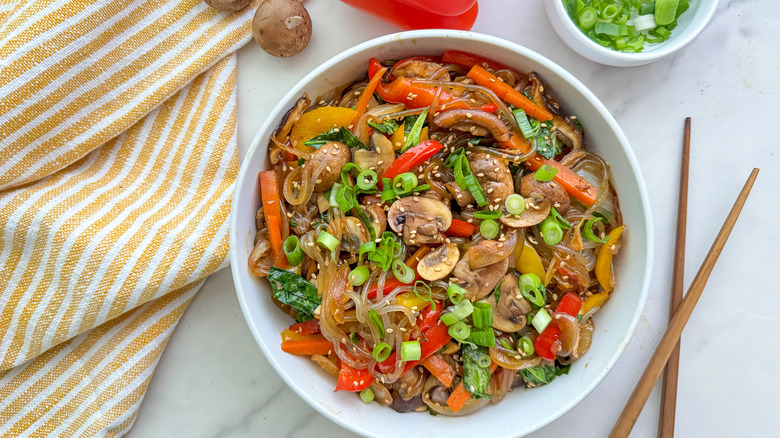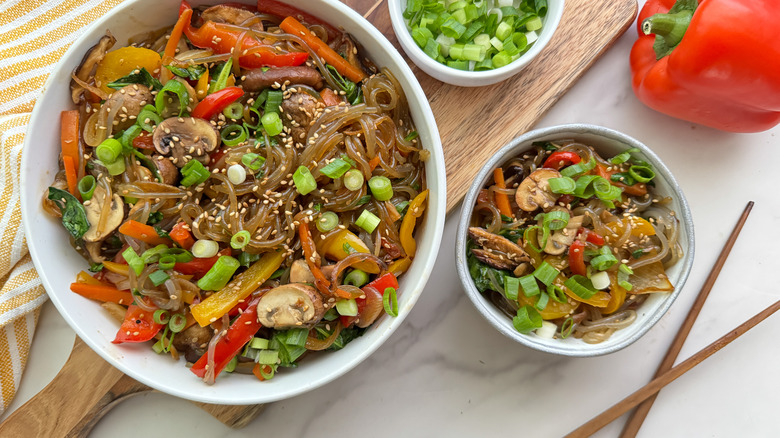Mushroom And Veggie Japchae Recipe
Fans of Korean cuisine are no doubt familiar with japchae, a delicious stir-fry dish featuring sweet potato glass noodles. Originating from Korea, japchae traditionally features meat, but our plant-based version brings a burst of flavors without the meaty element. The star of this dish is the sweet potato glass noodles, delivering a unique chewy texture and a mildly sweet taste. These translucent noodles, once cooked, become a perfect canvas for the tasty sauce and vegetables. Infused with a blend of soy sauce, coconut or brown sugar, sesame oil, and garlic granules, the dish achieves a savory and slightly sweet profile.
Wellness coach and recipe developer Miriam Hahn brings us this recipe and says, "The first time I tried sweet potato noodles I had no idea what to expect and was pleasantly surprised. They are delicious and a nice change from standard noodles." Paired with a plethora of veggies, this japchae recipe makes for a tasty lunch or dinner option.
Gather the ingredients for this mushroom and veggie japchae recipe
To make this recipe, start in the produce aisle and pick up onion, red pepper, yellow pepper, carrots, garlic, shiitake mushrooms, cremini mushrooms, and spinach. "I love how many vegetables are in this dish. The rainbow of colors makes it a beautiful presentation," Hahn says.
Then you'll need the sweet potato glass noodles along with some pantry staples like avocado oil, soy sauce, coconut or brown sugar, sesame oil, garlic granules, and sesame seeds.
Step 1: Hydrate the noodles
Place the noodles in warm water for 20 minutes to hydrate.
Step 2: Make the sauce
In a small bowl combine the soy sauce, sugar, sesame oil, garlic granules, and sesame seeds.
Step 3: Cook the noodles
Cook the noodles for 6-8 minutes until they are translucent.
Step 4: Drain and rinse the noodles
Drain the noodles and rinse under cold water.
Step 5: Add oil to a pan
Add 1 tablespoon of oil to a large frying pan over medium-high heat.
Step 6: Stir-fry the noodles
Add the noodles and stir-fry for 5 minutes, then remove them from the pan.
Step 7: Cook the vegetables
Add the remaining oil to the pan along with the onion and peppers and cook for 3 minutes.
Step 8: Add the carrots
Add the carrots and cook for 2 minutes.
Step 9: Add the garlic and mushrooms
Next, add the garlic and mushrooms and cook for 3 minutes.
Step 10: Combine ingredients
Add the noodles, sauce, and spinach to the pan. Stir to combine with the vegetables.
Step 11: Serve the japchae
Serve, garnished with additional sesame seeds if desired.
How can I customize this japchae?
It's easy to tailor the dish by mixing up the vegetables. You can use veggies like broccoli, snap peas, or bok choy for extra freshness and texture. Explore different types of mushrooms, such as oyster, portobello, or enoki, to enhance the mushroom profile. "When I'm making a dish like this, I tend to take a look in my refrigerator crisper to see what I have that might be on its last leg to add in. You can get very creative with stir-fries like this," Hahn shares.
Adjust the sweetness and depth of flavor by varying the amount of coconut or brown sugar. "Many Asian sauces go a little heavier on the sugar, so feel free to add more if you prefer a sweeter sauce," Hahn remarks. If you want the dish to have some heat, add a hint of spice with chili flakes, gochujang, or Sriracha for a kick.
For a heartier but still plant-based version, incorporate tofu or tempeh for added protein. You can cook those right in the pan before adding the vegetables or add them cooked to the finished dish.
What can I serve with this vegetable japchae?
There are many Korean banchan or side dishes that will go beautifully with japchae. A popular choice to complement many Korean meals is kimchi. Its crisp and crunchy texture adds a delightful contrast, contributing a satisfying crunch to the overall meal. "I love adding kimchi to all of my stir-fries. A little spoonful on each plate is just enough for a delicious bite and I love the fact that it helps with digestion," Hahn says.
A simple cucumber salad with a light vinegar dressing can offer a refreshing contrast to the savory japchae. Or you can go for a spicy cucumber salad cut accordion style for a beautiful presentation to the finished meal. The japchae ultimately makes for a meal all on its own, so it's up to you whether you want to serve it as the main course or as a side dish alongside plant-based proteins or meaty proteins like chicken or beef.
Mushroom and Veggie Japchae Recipe
This mushroom and veggie japchae features sweet potato glass noodles, mushrooms, and bell peppers, all stir-fried in a sweet-salty sauce.
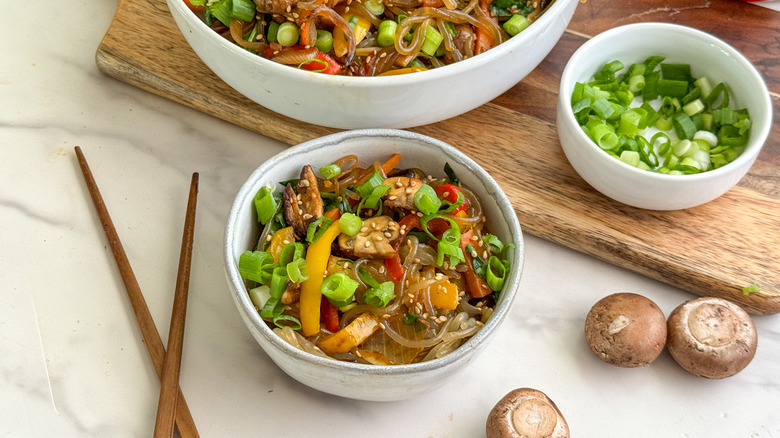
Ingredients
- 8 ounces sweet potato glass noodles
- ¼ cup soy sauce
- 2 tablespoons coconut or brown sugar
- 2 tablespoons sesame oil
- 1 teaspoon garlic granules
- 1 tablespoon toasted sesame seeds
- 2 tablespoons avocado oil
- ½ onion, sliced
- 1 red pepper, sliced
- 1 yellow pepper, sliced
- 1 carrot, julienned
- 2 garlic cloves, minced
- 1 cup sliced shiitake mushrooms, stems discarded
- 1 cup sliced cremini mushrooms
- 1 cup chopped spinach
Directions
- Place the noodles in warm water for 20 minutes to hydrate.
- In a small bowl combine the soy sauce, sugar, sesame oil, garlic granules, and sesame seeds.
- Cook the noodles for 6-8 minutes until they are translucent.
- Drain the noodles and rinse under cold water.
- Add 1 tablespoon of oil to a large frying pan over medium-high heat.
- Add the noodles and stir-fry for 5 minutes, then remove them from the pan.
- Add the remaining oil to the pan along with the onion and peppers and cook for 3 minutes.
- Add the carrots and cook for 2 minutes.
- Next, add the garlic and mushrooms and cook for 3 minutes.
- Add the noodles, sauce, and spinach to the pan. Stir to combine with the vegetables.
- Serve, garnished with additional sesame seeds if desired.
Nutrition
| Calories per Serving | 414 |
| Total Fat | 15.7 g |
| Saturated Fat | 2.1 g |
| Trans Fat | 0.0 g |
| Cholesterol | 0.0 mg |
| Total Carbohydrates | 61.8 g |
| Dietary Fiber | 3.8 g |
| Total Sugars | 7.9 g |
| Sodium | 1,001.8 mg |
| Protein | 7.3 g |
